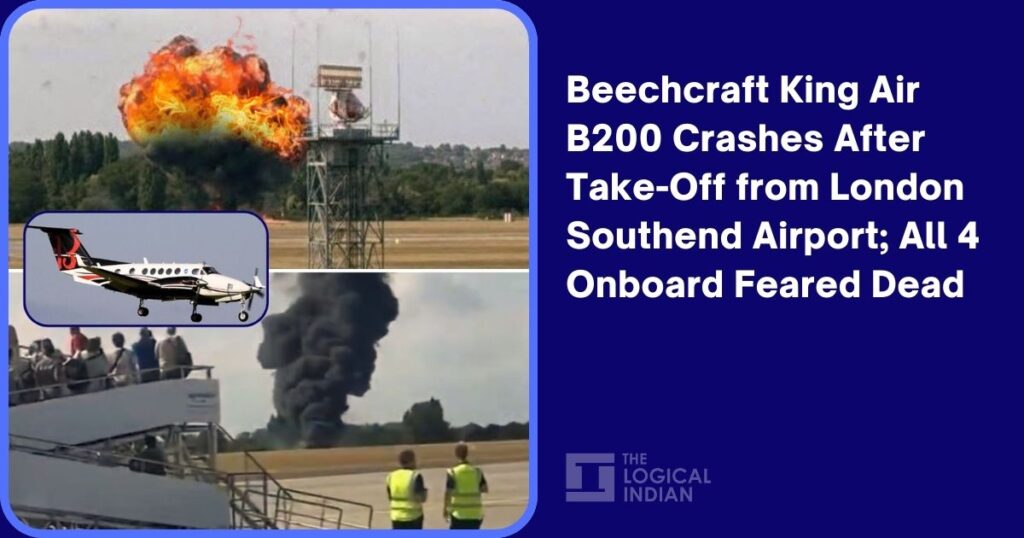🛩️ Plane Crashes in London and India: What Went Wrong and Are Planes Still Safe?
1. The Southend Shock: Small Plane Crash in London
On July 13, 2025, a Beechcraft B200 Super King Air (PH-ZAZ), operated by Dutch medevac firm Zeusch Aviation, crashed seconds after takeoff from London Southend Airport. The moment the aircraft veered, flipped, and fell was captured in dramatic footage showing a massive fireball and towering black smoke. Eyewitnesses, including golfers at the nearby Rochford Hundred Golf Club, described the impact as “I’ve never seen anything like it” and reported feeling heat from the blast The Financial Express+2People.com+2Wikipedia+2.
Emergency crews—police, fire, ambulance, and air ambulance—rushed to the scene. The situation was treated as a “serious incident,” prompting the airport to shut down and evacuate nearby facilities, including a golf and rugby club . As of now, details on the number of people aboard, injuries, or fatalities remain unconfirmed. The Air Accidents Investigation Branch (AAIB) and Essex Police are handling the investigation .
Despite being a small business aircraft, the crash highlights that aviation risk doesn’t respect size. Whether commercial jets or air ambulances, takeoff is universally the most precarious phase—any mechanical issue, loss of control, or pilot error immediately places an aircraft in danger.
2. Tragedy in Ahmedabad: The Air India Disaster
Just over a month earlier, on June 12, 2025, Air India Flight AI 171, a Boeing 787‑8 Dreamliner, crashed into a medical college hostel near Ahmedabad just 30 seconds after takeoff. Of the 242 onboard (230 passengers, 12 crew), 241 died, along with 19 on the ground—a total of 260 fatalities Gulf News+7Wikipedia+7India Today+7.
A disturbing revelation emerged within the AAIB’s preliminary report: both engines lost thrust because the fuel cutoff switches were moved from “RUN” to “CUTOFF” just seconds after liftoff—one after the other within one second Reuters+15Reuters+15India Today+15. The cockpit voice recorder captured one pilot demanding, “Why did you cut off?” and the other denying responsibility—“I didn’t” Reuters+11India Today+11Gulf News+11.
Though the engines were later returned to “RUN,” only one briefly regained thrust before failing again. The aircraft stalled and crashed about 0.9 nautical miles from the runway, deploying its emergency Ram Air Turbine (RAT) before impact Reuters+10Business Standard+10Gulf News+10.
Notably, the AAIB found no mechanical defects or maintenance issues. However, fuel switch locking mechanisms have been flagged by the FAA since 2018—but implementing upgrades remained non‑mandatory, and Air India didn’t inspect them India Today+11Al Jazeera+11Business Standard+11.
3. What’s Causing These Accidents?
It’s tempting to view two disasters in quick succession as part of a worrying pattern—but the root causes differ. Nevertheless, they expose systemic vulnerabilities within aviation safety:
A. Vulnerability During Takeoff
Takeoff is universally critical. These events—a small plane malfunctioning and a large jet suffering dual engine failure—underscore how quickly flights can turn catastrophic when issues arise early .
B. Human/Machine Interface Danger
In the Air India crash, the physical design of critical switches became a focal point. These required manual movement under a guard rail—no duty or awareness activated them from “RUN” to “CUTOFF” without physical manipulation ABC+14Business Standard+14www.ndtv.com+14. Obscurity in cockpit ergonomics seems to have been overlooked until tragedy.
C. Regulatory vs. Advisory Safety
The absence of mandatory enforcement for the FAA’s 2018 safety bulletin highlights a gap: critical safety enhancements can remain optional, making tragedies almost inevitable .
D. Cockpit Communication Under Duress
The AAIB’s report stressed confusion in the cockpit. Neither pilot admitted to moving the fuel cutoff. Whether it was an extreme error or subtle defect remains unclear Gulf News+2Business Standard+2India Today+2. Pressures in high-stress moments test crew resource management—and hierarchical cultures may inhibit assertive communication.
E. Safety Culture & Investigation Speed
Air India’s CEO warned the probe is “far from over,” urging caution before drawing conclusions Financial Times+15Reuters+15mint+15. Families have demanded a transparent impartial inquiry to counter fears of bias or misinformation .
4. Are Planes Still Safe?
Yes—in the global context, air travel remains one of the safest modes of transportation. Despite these terrible incidents, data show commercial aviation continues to achieve historic safety levels.
But these twin crashes reveal that safety relies crucially on:
-
Error‑forgiving design
Cockpit systems must account for human error—crucial controls like fuel switches should be protected with confirmed mechanical locks and redundancy. -
Mandatory safety upgrades
Advisory bulletins cannot remain voluntary when lives are at stake. Regulators must convert recommendations into enforced standards. -
Cockpit communication norms
Clear, flat communication—where co-pilots can challenge without fear—is essential. Crew Resource Management (CRM) training must be culturally adapted. -
Transparent investigations
Independent, cross-border probes ensure credibility and public trust, helping implement meaningful reforms.
5. What Comes Next?
✔️ For Air India / Boeing
-
Examine designs of fuel cutoff switches; consider redesign or adding confirmed locks.
-
Update pilot training to reinforce understanding and emergency protocol around these controls.
✔️ Regulators (FAA, DGCA, EASA, AAIB)
-
Review whether FAA advisory should be elevated to an enforceable airworthiness directive.
-
Require audits across airlines to ensure cockpit switch integrity.
✔️ Airlines & Pilots
-
Strengthen CRM training with real‑world simulations of unexpected emergencies.
-
Institute anonymous reporting, encouraging crew to flag near misses.
✔️ Public & Media
-
Demand transparency in accident reporting.
-
Support safety enhancements even when preliminary reports cite design or human error.
✈️ Conclusion: Learning from Tragedy
The Southend crash reminds us that no flight is routine—even a small plane can suffer dramatic failure. The Ahmedabad crash reveals how small design choices and communication breakdowns can spiral into catastrophe.
But rather than eroding confidence in flying, these events underline the continuous improvement nature of aviation safety. Each tragedy acts as a catalyst—prompting regulators, manufacturers, and airlines to learn, adapt, and invest in safer skies.
Are planes still safe? Absolutely. But “safe” doesn’t mean “infallible.” With every serious incident, the global aviation community gets an opportunity to plug safety gaps before they reoccur.
